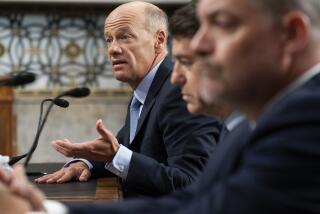Bank Industry’s Health Questioned : Insurance Fund Also Growing Weaker, Economists Warn
- Share via
WASHINGTON — Despite a string of record profits, hundreds of commercial banks and the government insurance fund that guarantees their deposits are far less healthy than they seem, analysts say.
The warnings are making members of Congress nervous just two months after they enacted a $50-billion, three-year bailout of the savings and loan industry.
Legislators remember all too well the reassurances that they heard from regulators and industry executives while the S&L; business was crumbling and how quickly hints of trouble mushroomed into the most dire financial crisis since the Depression.
Two well-known banking economists, Robert E. Litan of the Brookings Institution, a liberal think tank, and R. Dan Brumbaugh Jr. of Stanford University, report that commercial banks, though better off as a whole than S&Ls;, may be heading for trouble themselves.
Litan, appearing before the Senate Banking Committee last week, warned that about two-thirds of the reserves in the Federal Deposit Insurance Corp.’s bank fund will be needed for banks that are weak or already insolvent.
Expects Fewer Failures
At the end of June, FDIC’s bank reserves totaled $14.5 billion. But Litan and Brumbaugh say their analysis of bank data through March shows that $9.5 billion of that is needed to cover losses at banks that are insolvent or close to it, leaving only a thin $5-billion layer of protection before taxpayers would be called on to bail out the fund.
A post-Depression record of 221 banks failed last year. So far this year, 167 have closed or required government assistance to stay open--116 in Texas.
FDIC Chairman L. William Seidman says he expects failures for all of 1989 to be slightly below last year and to decline further in 1990.
However, a study by analyst William C. Ferguson of Irving, Tex., casts doubt on that. He said that 443 banks out of 13,000 nationwide have been losing money consistently from 1987 through the first quarter of this year.
“In spite of the high reported earnings of the banking industry (overall), the picture is not as rosy as it seems,” Ferguson said. “If present earnings trends for these (443) banks continue, this group will run out of capital by late 1990 or early 1991.”
The banking industry disputes its critics.
“Skeptics make a living peddling a different tune,” Nebraska banker C. G. Holthus, president-elect of the American Bankers Assn., told a House subcommittee. “We think they’re exaggerating the problem.”
By many measures, commercial banks, unlike savings and loans, are flourishing.
Banks earned a record six-month profit of $14.3 billion in the first half of 1989, on top of the record annual profit of $25.1 billion last year. And their three most pressing problems have all eased:
- The nation’s largest banks have added to their loss reserves, putting them in a better position to withstand a deterioration of shaky Third World debtor nations to repay the banks’ loans.
- The string of Midwestern bank failures has subsided with the recovery of the farm economy.
- The economies of Texas and other oil-producing states, where most of the failures are concentrated, appear to have bottomed out.
Moreover, the savings and loan bailout bill passed this summer nearly doubles the insurance premium paid by banks. That will provide an added $1.5 billion a year to help the fund recover from its first-ever loss in 1988.
“Simply put, the condition of commercial banks is not a thrift crisis in sheep’s clothing,” said James J. McDermott Jr. of Keefe, Bruyette & Woods Inc., an analyst who expresses more optimism than some of his colleagues.
Study Requested
Sen. John Heinz (R-Pa.) replied: “I’m not sure I’m reassured. . . . It’s a little bit like saying the United States is better off than Bangladesh.”
On the House side, Rep. Frank Annunzio (D-Ill.) has been voicing similar worries and last week asked Congress’ auditing arm, the General Accounting Office, to conduct a comprehensive study of the deposit insurance fund and the condition of banking.
“Although federal regulators paint a rosy picture of the industry, certain industry experts cast doubt on this assessment. I am deeply troubled over the concerns raised by these experts,” he said in a letter requesting the study.
The analysts identify two areas as the likely causes of the next banking crisis: large banks’ growing involvement in financing leveraged corporate buyouts and community banks’ decision to follow thrifts into real estate lending.
Bank real estate loans have soared 75% to $636 billion in 1988 from $364 billion in 1984, according to consultant Alex Sheshunoff.
More to Read
Inside the business of entertainment
The Wide Shot brings you news, analysis and insights on everything from streaming wars to production — and what it all means for the future.
You may occasionally receive promotional content from the Los Angeles Times.










